In honor of Women’s History Month, we bring you historical women who were royally fucked over in the name of sexism. All these women worked hard in their fields but ended up as ghostwriters, ghost filmmakers, ghost artists and ghost geneticists for their husbands who took all the recognition.

Alice Guy
In 1895, Alice Guy began working as the secretary for film industry pioneer Léon Gaumont, the inventor of phonoscope and biographe, a 60-millimeter motion picture camera. Alice borrowed the camera and made her first film. Gaumont saw her work and made her head of productions. Not long after, Alice started her own studio in Flushing, Queens called Solax. She produced, wrote and directed about 2 films a week, making her the first female film director and female studio owner.
According to Broadly, “She prioritized subverting social constructs and taboos, writing films that treated gender conventions as a social structure and then deconstructed them. While playwrights had employed cross-dressing since Shakespeare’s time, Guy was one of the first (if not the first) to dress women in men’s clothes to emphasize male privilege. “
Alice’s husband, Herbert Blaché, opened his own company, working out of Solax Studios. The two companies eventually merged and Herbert convinced Alice to have his name top-billed. He eventually convinced Alice to close Solax while he continued to make mediocre movies.

Zelda Fitzgerald
Though F. Scott Fitzgerald is one of the most prolific writers of American history, it has been rumored that some of his most famous lines came from his wife Zelda Fitzgerald, who was a writer in her own right. Taking inspiration from her life with Scott, she wrote a novel called Save Me The Waltz that was published in 1932, as well as many short stories which were published or co-published under her husband’s name. It said that F. Scott Fitzgerald was glad that Save Me The Waltz didn’t sell well because he wanted to use the same material in his own work.

Esther Lederberg
Esther Lederberg was a major trailblazer in bacterial genetics. With her husband, Joshua, she discovered the lambda phage, a bacterial virus which is widely used as a tool to study gene regulation and genetic recombination. In addition, she invented the replica plating technique, which is used to isolate and analyze bacterial mutants and track antibiotic resistance. Esther worked as her husband’s unpaid research assistant. They experimented with the way bacteria adapts and becomes immune to certain drugs. These finding led to Joshua receiving the 1958 Nobel Price for Physiology for medicine that he shared with two other people, neither of them his wife, neither of them female.
Esther also had trouble getting recognition in the academic field. At her funeral in 2006 Stanley Falkow, a colleague of Esther’s said, “She had to fight just to be appointed as a research associate professor, whereas she surely should have been afforded full professorial rank. “

Margaret Keane
Recently brought to the big screen in the Tim Burton movie Big Eyes, Margaret Keane was the real artist behind “the big-eyed waifs,” which were highly sought after art pieces in the 1960s. Her husband Walter Keane originally took credit for her art when he convinced her that he could sell more if he was the face behind the eyes. Two years into a happy marriage and in need of money, Margaret believed her husband. She spent the next years locked up in the home studio, where Walter would tell Margaret what she had to paint next. The marriage turned ugly, and with his newfound fame, Walter began cheating on Margaret. Margaret started to want credit for her own paintings, but Walter threatened Margaret’s life to make her continue with the lie. Margaret continued painting big-eyed waifs for Walter but she also began painting women in a different style and putting her own name on the paintings. Eventually, Margaret left Walter and admitted on a radio show that she was, in fact, the rightful artist and sued Walter. The court case ended when the judge ordered both Keanes to do a live demonstration of a big-eyed painting, and it was revealed that Margaret Keane was the artist behind the paintings.
More from BUST
9 Women You Didn’t Learn About In History Class But Should Have
The Forgotten Women Pilots Of WWII
How Hedy Lamarr Gave Us The Cell Phone
Zelda took material from her own life with Scott and wrote a novel titled ‘Save Me The Waltz,’ that was published in 1932. Her husband was angry at this, since he had wanted to use the material for his own book, and was happy when Zelda’s didn’t do very well.

